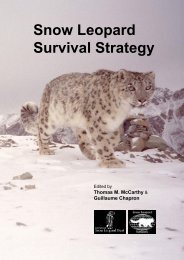Estimating the population density of Mongolian gazelles Procapra ...
Estimating the population density of Mongolian gazelles Procapra ...
Estimating the population density of Mongolian gazelles Procapra ...
You also want an ePaper? Increase the reach of your titles
YUMPU automatically turns print PDFs into web optimized ePapers that Google loves.
166<br />
K. A. Olson et al.<br />
Table 1 Survey effort and herd description <strong>of</strong> <strong>the</strong> four transect surveys for <strong>Mongolian</strong> <strong>gazelles</strong> conducted by vehicle in eastern Mongolia.<br />
Herd Size<br />
Distance No. <strong>of</strong><br />
Total no.<br />
Season Year driven (km) herds Mean P SD Range Median seen<br />
Spring 2000 1,398 174 161 P 442 1–4,000 26 27,985<br />
2002 1,229 149 96 P 221 1–2,000 22 14,327<br />
Autumn 2001 1,356 125 138 P 303 1–2,500 42 17,267<br />
2002 1,186 110 213 P 479 1–2,350 14 23,429<br />
Table 2 Strip width, effective strip width, selected models and parameters <strong>of</strong> <strong>the</strong> four transect surveys for <strong>Mongolian</strong> <strong>gazelles</strong> in eastern<br />
Mongolia.<br />
Strip width Effective strip No. <strong>of</strong> Model key,<br />
Season Year (m) width (m) intervals 1<br />
P 2<br />
P > x 2 no. <strong>of</strong> adjustments<br />
Spring 2000 1,001 440 7 0.55 0.87 Uniform cosine, 3<br />
2002 601 265 6 0.44 0.19 Half-normal cosine, 2<br />
Autumn 2001 650 352 6 0.54 0.82 Uniform cosine, 2<br />
2002 1,499 530 4 0.35 0.30 Half-normal cosine, 2<br />
1<br />
Probability <strong>of</strong> observing an object under <strong>the</strong> probability detection curve<br />
2<br />
Probability <strong>of</strong> a greater chi-square value<br />
We used a z-test to determine if a change in <strong>density</strong><br />
could be detected between surveys (Buckland et al.,<br />
2001). To increase precision <strong>of</strong> <strong>the</strong> estimates data for<br />
spring and autumn were combined and analysed according<br />
to <strong>the</strong> above procedure. We also used Distance to<br />
estimate <strong>density</strong> based on an 800-m strip (400 m each<br />
side), using <strong>the</strong> uniform key with no adjustments, for<br />
comparison between distance sampling analyses and<br />
strip transect analyses, <strong>the</strong> latter being simpler to<br />
analyse.<br />
Table 3 Density <strong>of</strong> herds observed, frequency observed per km,<br />
and estimated herd size (cluster size) by size-biased regression, for<br />
four transect surveys for <strong>Mongolian</strong> <strong>gazelles</strong> in eastern Mongolia.<br />
Density P SE Frequency P SE Cluster<br />
Season Year (per km 2 ) (per km) size P SE<br />
Spring 2000 0.11 P 0.02 0.09 P 0.02 109 P 32<br />
2002 0.17 P 0.04 0.09 P 0.02 58 P 16<br />
Autumn 2001 0.12 P 0.04 0.08 P 0.02 134 P 34<br />
2002 0.08 P 0.02 0.09 P 0.02 63 P 23<br />
Results<br />
We counted 110–174 groups <strong>of</strong> 1–4,000 <strong>gazelles</strong> during<br />
<strong>the</strong> surveys; among years, mean group size was 96–213<br />
and median group size 14–42 (Table 1). For distance<br />
sampling analyses, selected strip widths varied between<br />
601 and 1,499 m, and uniform-cosine or half normalcosine<br />
models provided <strong>the</strong> best fit at <strong>the</strong> centre lines <strong>of</strong><br />
<strong>the</strong> transects (i.e. where observability is assumed to be<br />
1.0; Table 2). The contribution <strong>of</strong> small clusters to <strong>the</strong><br />
overall estimated <strong>population</strong> size was minimal (Table 3).<br />
In <strong>the</strong> 80,000 km 2 survey area, densities estimated from<br />
distance sampling analyses in spring were 9.9–11.5<br />
<strong>gazelles</strong> km −2 , averaging 10.7 <strong>gazelles</strong> km −2 , giving a<br />
point estimate <strong>of</strong> c. 800,000 (Table 4). Densities in autumn<br />
were 5.4–15.8 <strong>gazelles</strong> km −2 , averaging 11.5 <strong>gazelles</strong><br />
km −2 , or c. 870,000 <strong>gazelles</strong> in total, similar to <strong>the</strong> spring<br />
estimate (Table 4). There were no detectable differences<br />
in densities among surveys (P g 0.22). Combined<br />
seasons provided more precise estimates (Table 4);<br />
Table 4 Density and <strong>population</strong> estimates from line transect<br />
surveys, driven in <strong>the</strong> eastern steppe <strong>of</strong> Mongolia during 2000 to<br />
2002, calculated by distance sampling and strip transect (800 m<br />
width) analyses.<br />
Density P SE Population<br />
Season Year (per km 2 ) estimate (95% CI)<br />
Distance sampling analysis<br />
Spring 2000 11.5 P 4.1 860,380(431,460–1,715,700)<br />
2002 9.9 P 3.6 742,460(408,020–1,351,000)<br />
Combined 10.7 P 2.8 803,820(483,790–1,330,100)<br />
Autumn 2001 15.8 P 6.3 1,186,000(537,100–2,619,000)<br />
2002 5.4 + 2.3 401,320(177,150–909,120)<br />
Combined 11.5 P 3.2 870,625(499,432–1,491,278)<br />
Strip transect analysis<br />
Spring 2000 16.3(7.5–35.4) 1,218,800(559,330–2,655,800)<br />
2002 6.9(3.6–13.2) 514,600(266,920–990,020)<br />
Combined 9.3(5.2–16.6) 694,080(388,110–1,241,300)<br />
Autumn 2001 11.2(5.2–24.2) 841,950(391,150–1,812,300)<br />
2002 11.4(5.3–24.3) 852,680(399,240–1,821,100)<br />
Combined 11.2(6.8–18.5) 842,280(511,420–1,387,200)<br />
© 2005 FFI, Oryx, 39(2), 164–169
















